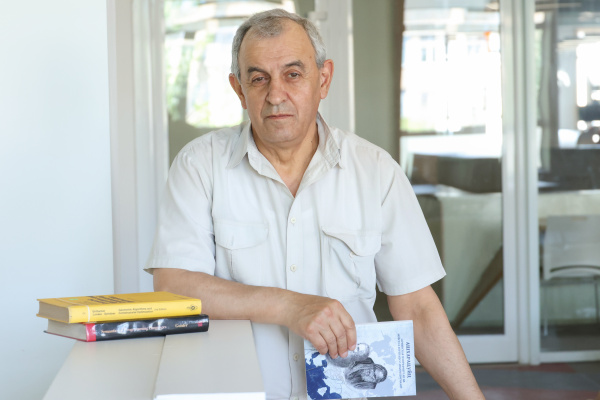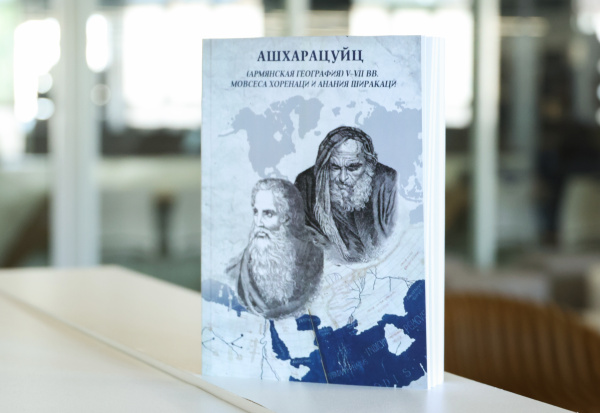July 02, 2024 | 13:30
Science
Research
Publications and scientific journals
YSU Professor - Author of New Discoveries in “Ashkharatsuyts”
“Ashkharatsuyts” (“Ancient Armenian Geography”), compiled by Movses Khorenatsi in the 5th century and supplemented by Anania Shirakatsi in the 7th century, continues to be the focus of scholarly attention. Hakob Harutyunyan, a lecturer at the Department of World History at Yerevan State University and Doctor of Historical Sciences, has authored more than 40 scientific articles on “Ashkharatsuyts”, seven of which have been published in high-rated journals indexed in the international scientometric database Scopus."

After conducting a detailed study of “Ashkharatsuyts,” the author focused on the region of Lycaonia, which historically occupied the territory adjacent to the modern city of Antalya on the Asia Minor peninsula. An article titled 'From the Geography of Ancient Lycaonia to the Works of Khorenatsi and Shirakatsi' was published in the journal 'Bulletin of St. Petersburg University.' This work by Professor Hakob Harutyunyan from Yerevan State University represents the first scientific publication on Lycaonia in the academic world. 'Before this, no scientific article on Lycaonia had been published in any language. In addition, “Ashkharatsuyts” briefly mentions this region in a single sentence, describing it as a high-mountainous country,' noted H. Harutyunyan.

In presenting the results of his research, the author emphasized that various peoples inhabited the territory of Lycaonia, and intense wars were continually waged among the states of this region to assert dominance. Professor Harutyunyan added that he also examined the shifts in power that occurred in Lycaonia, documenting how control of the territory passed from one country to another. 'Tigran the Great had a strong desire to annex Lycaonia to Greater Armenia to establish dominance over Asia Minor, but he was unable to realize this plan. His military campaigns were primarily focused southwards, ultimately reaching Egypt.
“Ashkharatsuyts” contains information about 58 countries and also briefly presents facts about the flora and fauna of these regions. It describes 12 European, 8 African, and 38 Asian countries, including those that were destroyed in the 5th-7th centuries. The first two books of “Ashkharatsuyts” serve as an introduction, outlining the basic principles of geography study.
In his articles on “Ashkharatsuyts”, H. Harutyunyan also explores ancient Spain, Britain, Germany, Gaul, Dalmatia, Italy, Macedonia, Greece, Thrace, China, Parthia, Phrygia, and writes about Byzantine Armenia, Asia, and many other states. The Yerevan State University professor noted that his goal is not limited to current achievements; he intends to study all 58 countries represented in “Ashkharatsuyts”. The scientist has already researched approximately 40 countries or regions. 'I have thoroughly studied all 12 European countries as described in “Ashkharatsuyts”, on which I have published scientific articles, and have nearly completed the study of 38 Asian states. There remain 8 African countries yet to explore,' noted the scientist.

H. Harutyunyan pointed out that until recently, information from “Ashkharatsuyts” was primarily utilized in relation to Armenia and its neighboring countries, including the two Georgian states of Iberia and Colchis, Caucasian Albania, and partially the North Caucasus and Persia. “Ashkharatsuyts” contains intriguing details about Persia, Iran, and 16 states situated on the Asia Minor peninsula. It also provides information about Elam, the first Persian state founded in the 3rd century BC. The Armenian source text mentions the Parthian kingdom, which the authors of “Ashkharatsuyts” present as a Persian state," noted scientist H. Harutyunyan․
The Mesrop Mashtots Institute of Ancient Manuscripts (Matenadaran) houses a large number of “Ashkharatsuyts” manuscripts written in Old Armenian (Grabar). Over time, these manuscripts have been translated into various languages: Latin, English, French, Russian, etc.
Professor A. Harutyunyan believes that the best translation of “Ashkharatsuyts” from Old Armenian to modern Armenian is the work of A.G. Abrahamyan and the former rector of YSU, G.B. Petrosyan, despite the fact that the translators were unable to translate some lexical units, such as names of animals, plants, etc., and left them in the translated text in Grabar. Only the short version of M. Khorenatsi's “Ashkharatsuyts” has been translated into Russian, authored by K.P. Patkanov. The full text of the Armenian source, supplemented by A. Shirakatsi, which is called the expanded version, was translated into Russian by YSU Professor A.Zh. Harutyunyan. The Russian-translated text of “Ashkharatsuyts” was published in Russia and distributed by publishers to several major libraries in the Russian Federation.
'I translated the original text of “Ashkharatsuyts” (about 55 pages) from Grabar to Russian in 4 months, but I worked on the already translated text for about 4 years to bring it as close as possible to the original. Moreover, I presented almost all proper names, such as names of peoples, lakes, rivers, seas, countries, cities, etc., not only in Russian but also in Latin and Greek,' said Professor A. Harutyunyan, emphasizing that he encountered some difficulties in translating animal and plant names from Grabar to Russian and had to use up to 15-20 dictionaries for a single lexical unit, and in some cases, seek help from local and foreign colleagues.
It should be noted that YSU Professor A. Harutyunyan is the author of more than 200 scientific articles and 7 books. His works have been published in Armenia, Russia, Ukraine, Belarus, Kazakhstan, Moldova, Norway, Lebanon, and Austria.

